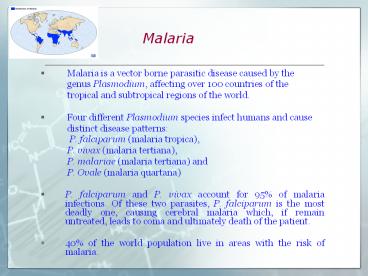Malaria - PowerPoint PPT Presentation
Title:
Malaria
Description:
Malaria is a vector borne parasitic disease caused by the genus Plasmodium, affecting over 100 countries of the tropical and subtropical regions of the world. – PowerPoint PPT presentation
Number of Views:207
Avg rating:3.0/5.0
Title: Malaria
1
Malaria
- Malaria is a vector borne parasitic disease
caused by the - genus Plasmodium, affecting over 100
countries of the - tropical and subtropical regions of
the world. - Four different Plasmodium species infect humans
and cause - distinct disease patterns
- P. falciparum (malaria tropica),
- P. vivax (malaria tertiana),
- P. malariae (malaria tertiana) and
- P. Ovale (malaria quartana)
- P. falciparum and P. vivax account for 95 of
malaria infections. Of these two parasites, P.
falciparum is the most deadly one, causing
cerebral malaria which, if remain untreated,
leads to coma and ultimately death of the
patient. - 40 of the world population live in areas with
the risk of malaria.
2
Malaria
- Around 300-500 million clinical cases of malaria
are reported every year, of which more than a
million die of severe and complicated cases of
malaria. - Malaria is known to kill one child every 30 sec,
3000 children per day under the age of 5 years. - Malaria ranks third among the major infectious
diseases in causing deaths after pneumococcal
acute respiratory infections and tuberculosis,
and accounts for approximately 2.6 of the total
disease burden of the world. - Although malaria has been widely eradicated in
many parts of the world, the global number of
cases continues to rise. The most important
reason for this alarming situation is the rapid
spread of malaria parasites that are resistant to
antimalarial drugs.
3
Malaria
- Malaria parasites are transmitted from one person
to - another by the female anopheline mosquito.
- The males do not transmit the disease as they
feed only on plant juices. - There are about 380 species of anopheline
mosquito, but only 60 or so are able to transmit
the parasite.
4
Malaria Life Cycle
- Mosquito infected with the malaria parasite bites
human, passing cells called sporozoites into the
humans bloodstream. - Sporozoites travel to the liver. Each sporozoite
undergoes asexual reproduction, in which its
nucleus splits to form two new cells, called
merozoites. - Merozoites enter the bloodstream and infect red
blood cells. - In red blood cells, merozoites grow and divide to
produce more merozoites, eventually causing the
red blood cells to rupture. Some of the newly
released merozoites go on to infect other red
blood cells.
5
Malaria Life Cycle
- Some merozoites develop into sex cells known as
male and female gametocytes. - Another mosquito bites the infected human,
ingesting the gametocytes. - In the mosquitos stomach, the gametocytes
mature. Male and female gametocytes undergo
sexual reproduction, uniting to form a zygote. - The zygote multiplies to form sporozoites, which
travel to the mosquitos salivary glands. - If this mosquito bites another human, the cycle
begins again
6
Artemisinin A major breakthrough in malaria
chemotherapy
- In 1967, the Chinese government launched a
program to discover new antimalarial drugs from
indigenous plants. - The first written record of the antipyretic
activity of tea-brewed leaves of Artemisia annua
( See Fig. ) was described in "The Handbook of
Prescriptions for Emergency Treatments" written
by Ge Hong (281-340 A.D.). - In 1971, Chinese researchers isolated, by
extraction at low temperature from A. annua
(Sweet wormwood), a stable easily crystallizable
compound that they named Qinghaosu and later on
named artemisinin 8.
7
mode of action of artemisinin
- Digestion of hemoglobin releases heme. Free heme
is toxic due to its ability to destabilize and
lyse membranes, as well as inhibiting the
activity of several enzymes. - The free heme destabilises the food vacuolar
membrane and other membranes and leads to the
death of the parasite. - For this reason the parasite convert the free
Heme to Hemozoin.
8
mode of action of artemisinin
HEMOGLOBIN
HEME GLOBIN(PROTEIN PART)
HEMOZOIN
HEME
HEMOZOIN
9
Pharmacophore for antimalarial activity
- 1,2,4-trioxane is the basic pharmacophore
responsible for antimalarial activity.
10
This powerpoint was kindly donated
to www.worldofteaching.com http//www.worldoftea
ching.com Is home to well over a thousand
powerpoints submitted by teachers. This a free
site. Please visit and I hope it will help in
your teaching































